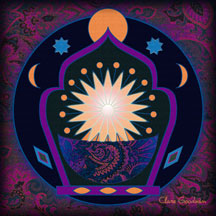 Basic Elements
Basic Elements How to Draw
How to Draw Useful Points
Useful PointsThe Basics

Mandalas are everywhere! It may have all started with the Buddhists, and they certainly are at the center of it all, but circular images are a deep part of every human psyche. MandalaMaker will help you to explore both mandalas and yourself.
The road to MandalaMaker mastery is not long or difficult, and once you get to know the program, creating images is both fun and intuitive. This orientation will help you to get the most out of the software.
Our Design Philosophy
In developing MandalaMaker it was our intent to build a powerful yet easy to use application for drawing radially symmetrical designs, both traditional and contemporary. Version 2 adds a host of new features, but we have tried to keeps the interface as straightforward as possible.
MandalaMaker is a vector based drawing application. This means that each shape that you draw maintains its identity and can be altered, moved or deleted at any time. It also means that MandalaMaker drawings are essentially resolution independent and can be resized on output to suit your needs.
In version 1 of the program, manipulation of objects within a drawing was handled exclusively through simple slider and button controls on a handful of palettes and panels. This approach provides for accurate and predictable results, but lacks some of the hands-on intuitiveness that artists enjoy when using real world media such as paints or pencils.
In version 2, while retaining most of the familiar controls, we have made it possible to manipulate many object properties by dragging with the mouse directly on the image.
We receive feature requests regularly and we have incorporated many of them in version 2. We plan on implementing many more features as time goes on. Please feel free to let us know of things you would like to see included in the program, but we encourage you to explore what MandalaMaker CAN do rather than focusing on what you wish it could do.
The range of images and effects possible with the first version of the program was truly staggering. With the addition of transparency, gradients and a gaggle of new shapes, MandalaMaker 2 opens up whole new vistas for exploration.
We wrote MandalaMaker and work with it on a daily basis, yet we surprise ourselves regularly with new techniques and the unexpected consequences of combining them. We hope that you will enjoy exploring MandalaMaker as much as we do!
"Much of the beauty that arises in art comes from the struggle
an artist wages with his limited medium."
- Henri Matisse
Basic Elements
The Center
The essence of a mandala design is its organization around the center. In MandalaMaker, all drawing elements are created in reference to the center of the drawing, making it easy to create the radial symmetry required for mandalas.
Shapes
The Shapes are an array of geometrical forms which comprise the structure of a MandalaMaker drawing. Each type of Shape has one or more attributes which can be adjusted to alter its appearance.
All Shapes have two aspects which can be painted independently: the Line, which is the outline of the shape, and the Fill, which is the interior area of the Shape.
You can learn all about MandalaMaker Shapes in the Working with Shapes section.
Paints
If Shapes are the bones of a MandalaMaker drawing, then Paints are the flesh and blood. Paints are the colors with which shapes are painted. Paints can be opaque or can have various levels of transparency. They may be flat, overall colors or they may be gradients, which subtly blend two colors either radially or linearly. To find out all about Paints read the Working with Paints section.
The Canvas
The Canvas is the on-screen representation of your mandala. The Canvas also allows you to interact directly with drawing elements. You can select Shapes by clicking on them in the Canvas, and when a Shape is selected you can alter some of its attributes by dragging the Shape's selection handles.
The Palettes
MandalaMaker has a number of small floating windows which give you control over various aspects of your drawing:
How to Draw with MandalaMaker
Drawing a mandala with MandalaMaker is basically a process of adding shapes to the Canvas and adjusting them until the mandala is finished to your satisfaction. The basic steps of drawing with MandalaMaker are as follows:
Of course, there are lots of options, nuances and details that you'll learn about in the rest of this manual, but that's essentially all there is to it!
"I've always been fascinated with the idea that complexity can come out of such simplicity."
- Will Wright
Important and Useful Points